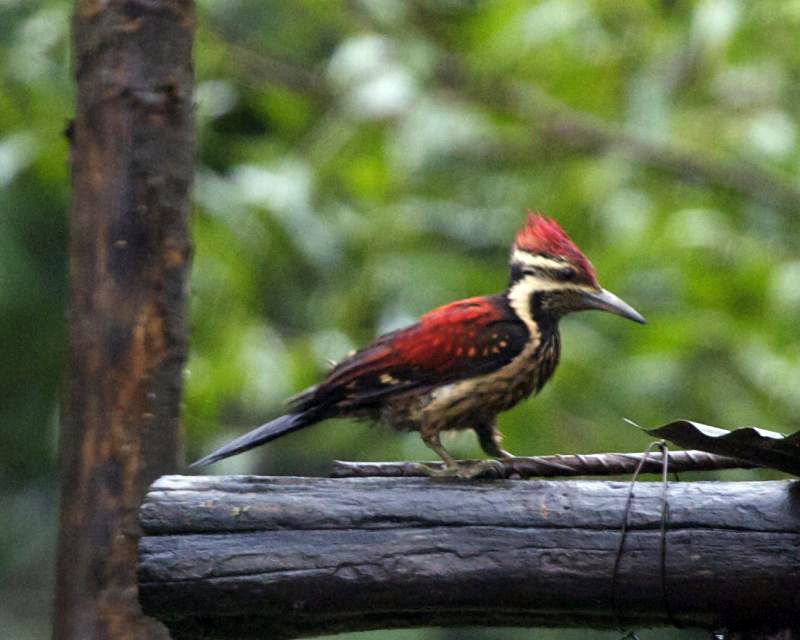Black-rumped Flameback
A species of Dinopium Flamebacks Scientific name : Dinopium benghalense Genus : Dinopium Flamebacks
Black-rumped Flameback, A species of Dinopium Flamebacks
Botanical name: Dinopium benghalense
Genus: Dinopium Flamebacks
Content
Description General Info
 Photo By Lip Kee , used under CC-BY-SA-2.0 /Cropped and compressed from original
Photo By Lip Kee , used under CC-BY-SA-2.0 /Cropped and compressed from original Description
The black-rumped flameback is a large species at 26–29 cm in length. It has a typical woodpecker shape, and the golden yellow wing coverts are distinctive. The rump is black and not red as in the greater flameback. The underparts are white with dark chevron markings. The black throat finely marked with white immediately separates it from other golden backed woodpeckers in the Indian region. The head is whitish with a black nape and throat, and there is a greyish eye patch. Unlike the greater flameback it has no dark moustachial stripes. The adult male has a red crown and crest. Females have a black forecrown spotted with white, with red only on the rear crest. Young birds are like the female, but duller. Like other woodpeckers, this species has a straight pointed bill, a stiff tail to provide support against tree trunks, and zygodactyl feet, with two toes pointing forward, and two backward. The long tongue can be darted forward to capture insects. The black-rumped flameback is the only golden-backed woodpecker with both a black throat and a black rump. Leucistic birds have been recorded. Two specimens of male birds from the northern Western Ghats have been noted to have red-tipped feathers on the malar region almost forming a malar stripe. A female specimen from Lucknow has been noted to have grown an abnormal downcurved hoopoe-like bill. 
Size
29 cm
Colors
Black
Yellow
Red
Gray
White
Nest Placement
Cavity
Feeding Habits
Black-rumped Flameback often forage in pairs, eating beetle larvae, insects, and nectar; they hop on branches from ground to canopy and may join mixed-species groups.
Habitat
The black-rumped Flameback predominantly occupies open forests and cultivated regions, extending to elevations of about 1200m, but can be found up to 1700m in some areas. Their habitat ranges across varied woodland types, from moist to dry and primarily deciduous. In rural settings, they are commonly found in groves, wooded gardens, and tree plantations along roads and canals, while adapting well to urban areas with tree-lined streets. The species favors Borassus palms, coconut, and rubber plantations in Southern regions but tends to avoid dense forests and arid landscapes.
Dite type
Insectivorous
General Info
Feeding Habits
Bird food type
Behavior
This species is normally seen in pairs or small parties and sometimes joins mixed-species foraging flocks. They forage from the ground to the canopy. They feed on insects mainly beetle larvae from under the bark, visit termite mounds and sometimes feed on nectar. As they make hopping movements around branches, they often conceal themselves from potential predators. They adapt well in human-modified habitats making use of artificial constructions fallen fruits and even food scraps. The breeding season varies with weather and is between February and July. They frequently drum during the breeding season. The nest hole is usually excavated by the birds and has a horizontal entrance and descends into a cavity. Sometimes birds may usurp the nest holes of other birds. Nests have also been noted in mud embankments. The eggs are laid inside the unlined cavity. The normal clutch is three and the eggs are elongate and glossy white. The eggs hatch after about 11 days of incubation. The chicks leave the nest after about 20 days. 
Distribution Area
This flameback is found mainly on the plains going up to an elevation of about 1200m in Pakistan, India south of the Himalayas and east till the western Assam valley and Meghalaya, Bangladesh and Sri Lanka. It is associated with open forest and cultivation. They are often seen in urban areas with wooded avenues. It is somewhat rare in the Kutch and desert region of Rajasthan. 
Species Status
Not globally threatened.
Scientific Classification
Phylum
Chordates Class
Birds Family
Woodpeckers Genus
Dinopium Flamebacks Species
Black-rumped Flameback